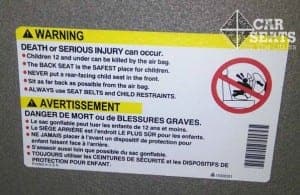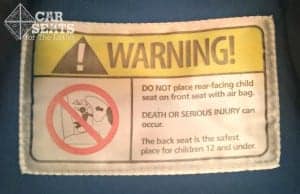For kids, the right seat is the vehicle’s back seat.
Have you ever read the warning behind your sun visor in the passenger side of your car?
Have you ever seen this sticker on your child’s car seat?
Both of these warnings are so ubiquitous that maybe you haven’t stopped to read them (or, maybe, your kids are so loud and busy that you haven’t had the chance). These federally mandated warnings say the same thing: the vehicle’s back seat is the safest place for children under age 13 to ride. Sometimes, this warning reads “12 and under”, but the recommendation remains the same: kids should ride in the back seat if at all possible before they turn 13.
Why should kids ride in the back? Two main reasons: first, it has been the safest place to ride for most of automobile history, and second, the airbags in modern cars are not made to protect pre-pubescent bodies. Let’s look at the evidence behind this recommendation in more detail.
The back seat is usually the safest place for any passenger to ride.
The recommendation to buckle children in the vehicle’s back seat is part of an evolving suite of technological and public health advances. These advances have reduced childhood injury and death due to vehicle crashes. The rate of children dying in car crashes has decreased by 60 percent between 1975 and 2013 (IIHS Fatality Facts). This is great progress!
Other advances in vehicle safety include lap-shoulder seat belts, modern child restraints, airbags and other technological innovations. In addition, public health campaigns aimed at parents and care givers have brought safety into the forefront of public awareness.
I can’t be the only person in her thirties who remembers Big Bird saying “Kids in the back seat!” and the kids answering “and buckle up!”
Truly, we have made great strides in vehicle safety in this time. Despite these advances, children are still fatally injured in the front seat when the back seat offers such superior protection. While 46% of childhood deaths in cars happened to front seat passengers in 1975, 15% happened to front seat passengers in 2013. This means that there are still deaths that can be prevented by safely restraining children in the rear of the vehicle (IIHS Fatality Facts).
At the same time that Big Bird was reminding parents, and kids, that children should ride in the vehicle’s back seat, airbag technology became standard safety equipment. Airbags began being installed in passenger vehicles in the 1980s and dual airbags were mandated in the US in 1998.
Front airbags are not safe for small bodies
Airbags are life saving technology and cars are much safer since they have become a standard safety feature. NHTSA estimates that in 2002 alone 2,288 lives were saved by frontal airbags (NHTSA , 2009). Frontal airbags however, are designed to protect adults. The Children’s Hospital of Philadelphia estimates that children are twice as likely to be seriously injured if they are exposed to an airbag (CHOP, Airbags). In a frontal accident, airbags explode using nitrogen gas at about 200 miles per hour. This instantaneous explosion, designed for the size and bones of an average adult wearing a seat belt, can be deadly for a child, even one wearing a seat belt.
Even in vehicles made after 2004 that are equipped with advanced airbags, the back seat remains the safest place for children to ride. The newest airbags are much more complex than those of previous decades. They use sensors throughout the car and front seat to adjust how and when the airbag deploys in different types of crashes. These advanced frontal airbags, however, are still designed for an adult and are still dangerous for children.
Several studies have considered only modern vehicles and concluded that children are significantly safer in the back seat. Studies in 2000 (Berg 2000) and 2005 (Durbin 2005) both confirmed that children in the front seat were at up to a 40% greater risk of injury and urge that appropriate restraints be used in concert with keeping children under age 13 in the back seat.

At 11.5 years old, this Big Kid is big enough to use the seat belt, and still young enough to be vastly better protected in the back seat.
What about those times when kids might need to ride in the front seat? There are situations when the only appropriate seat for all children (even rear facing ones) may be the front. For example, a two-seater car, or a truck without a back seat. If this one row vehicle has an airbag that turns off with a key or if there is no airbag, the front seat is the only place for a child to ride. A situation where a caregiver absolutely must transport four children in a five person vehicle (and all other resources, including alternate care and public transportation have been exhausted), that parent might need to make the tough decision to put a child under the age of 13 in the front seat in an appropriate restraint with the seat pushed as far back as possible. In an older car where there is only a lap shoulder belt in the front seat and the child in question has outgrown appropriate harnessed seats, the front seat might be the best choice. These are not the most common situations.
More common is parents interpreting legal minimums as safety standards, or briefly bending their rules in the belief that one time in the front seat couldn’t hurt. Unfortunately, laws do not reflect the safest choice, and since children are so much more likely to suffer injury or death in the front seat, one time very much could hurt.
A study in Injury Prevention on urban parents suggested that though drivers knew that the back seat was the right seat for kids, they would periodically let their kids ride in front, either in response to social pressure, or as a treat (Lennon, 2007). In other words, even though these parents had a rule about kids in the back seat, they would sometimes bend the rules. We know that as parents, it’s our job not to give in to peer pressure to make an unsafe choice. We also know that not giving in isn’t always easy, but the overwhelming evidence of the last thirty years says that the front seat is just too risky to be used as a treat. Just like everyone needs a seat belt if the car is going to move, kids need to be buckled up in the right seat for every trip, no matter how short. The seat belt rule applies to adults and the back seat rule applies to big kids too: crashes happen close to home, on short trips and in an instant.
In the past decades we’ve made great strides in car safety and child restraint technology. But even with these advances, kids still benefit overwhelmingly from not riding in the front seat (Arbogast 2009) for two simple reasons: first the back seat is the safest place to ride and second the safety features of the front seat aren’t designed to protect small immature bodies. In most cases keeping kids in the back seat is simple, and this one simple act can put your child (probably your big kid) at a 40% lower risk of suffering injury or death. Keeping kids in the back seat long after the legal requirement is, in most cases, the easiest thing you can do to protect your children in the event of a vehicle crash. When used in concert with the right car seat or booster for your children who don’t yet fit in the seat belt, this one simple choice could save your child’s life.
Arbogast KB, Kallan MJ, Durbin DR. Front versus rear seat injury risk for child passengers: evaluation of newer model year vehicles. Traffic Inj Prev. 2009 Jun;10(3):297-301. doi: 10.1080/15389580802677799.
Marc D. Berg, et. al. Effect of Seating Position and Restraint Use on Injuries to Children in Motor Vehicle Crashes. Pediatrics Vol. 105 No. 4 April 1, 2000 pp. 831 -835. Retrieved from http://pediatrics.aappublications.org/content/105/4/831.abstract
Children’s Hospital of Philadelphia. Car Seat Safety for Kids: Airbags. Retrieved from http://www.chop.edu/pages/air-bags#.VebF9c6sY-8
Dennis R. Durbin, et. al. Effects of Seating Position and Appropriate Restraint Use on the Risk of Injury to Children in Motor Vehicle Crashes. Pediatrics Vol. 115 No. 3 March 1, 2005 pp. e305 -e309 doi: 10.1542/peds.2004-1522
Insurance Institute of Highway Safety Highway Loss Data Institute. Fatality facts: Child Safety. Retrieved from http://www.iihs.org/iihs/topics/t/child-safety/fatalityfacts/child-safety
Alexia Lennon. A risky treat: exploring parental perceptions of the barriers to seating their children in the rear seats of passenger vehicles
Inj Prev 2007;13:2 105-109. doi:10.1136/ip.2006.012906.
(DOT HS 811 206). Retrieved from http://www-nrd.nhtsa.dot.gov/Pubs/811206.pdf




